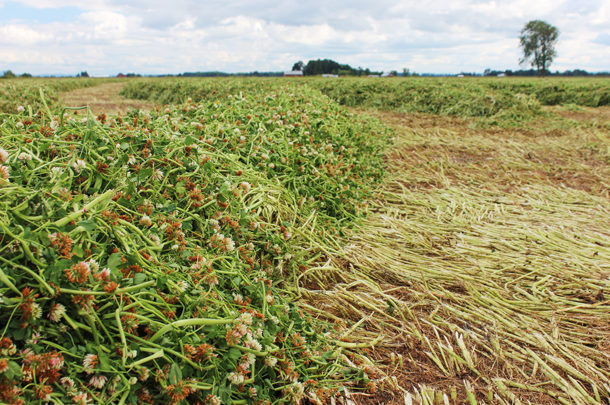“Cover crops are any crops not considered a cash crop as they are not harvested for a sellable product. Once cover crops are utilized within a forage system, such as overseeding a berseem clover into an alfalfa field, they become forage applications,” says Hall. “Depending on the species and quality of variety used, forage producers can significantly increase yields and quality by taking advantage of the soil structure improvement, added biomass and even free nitrogen fixation traits some cover crops provide.”
Improve grassland
One cost-effective and quick way to turn around tired grassland is by adding different plant species, such as legumes, into pasture through overseeding.
“Just because grass is green and growing doesn’t mean it’s performing well. Often, the biggest issue found in pastures is poor fertility due to not receiving adequate nutrients, resulting in grass to be barely limping along,” explains Hall. “Nitrogen-fixing legumes such as balansa or berseem clovers are a great way to get an immediate bang for your buck in forage yield and quality increases.”
Grow super silage
Whether being grown as a monoculture, with small grains or in a corn silage rotation, balansa clover’s nitrogen fixation and weed control makes it a viable option for silage – with forage yields of 20 tons per acre being obtainable with the right variety.
“Using a variety that can handle extreme environmental conditions, such as sub-degree temperatures without snow cover, is essential for increasing growing seasons and utilizing flexible seeding options,” says Hall. “And if producers want to take multi-cuts or utilize it within a grazing rotation, then the variety also needs to be later maturing.”
Increase alfalfa quality and yield
In a two-year study by King Saud University in Saudi Arabia, a 20 percent berseem clover to 80 percent alfalfa ratio was the highest dry yield mixture on trial while also proving to increase crude protein and carbohydrate yield. This synergistic relationship and the species having similar phenotype and feed value makes them a desirable combination for hay producers.
Quality matters
As producers begin to research which cover crop varieties would best suit their operation as a forage application, it is crucial they select quality varieties of a species to capture the full benefits.
“It goes back to the old saying of ‘garbage in, garbage out,’” Hall says. “Just because one variety of balansa clover has cold tolerant traits or is later maturing doesn’t mean every variety of balansa clover has those same traits – there is a lot of research that goes into breeding different varieties. When used as forage applications, the right variety of cover crops can bring a lot of positive benefits to producers.” ![]()

-
Laura Mushrush
- Freelancer
- Agribusiness Communications Limited
- Email Laura Mushrush
PHOTO: Forage yields of 20 tons per acre are obtainable when the right variety of a species is selected. Photo provided by Laura Mushrush.











